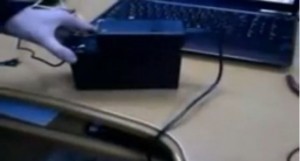Electricity Rations Plunge Damascus into Darkness

By Salam al-Saadi
(Damascus, Syria) — These days, it requires more patience and fortitude than usual for 12-year-old Samer to do his homework, which he labours over by the dim light of what the family calls a “power charger” – a small, rechargeable, battery-powered device that can provide up to three hours of electricity – as the house around him remains immersed in darkness.

Many Syrians have come to depend on these power chargers for light as the country has faced some of the worst power outages since the beginning of the conflict. They are sold throughout the Damascus metro area.
“Studying is real suffering without a strong light,” he said. “Despite that, my father said that we’re a lucky generation because we have the charger, while for years he had to study by kerosene.”
But Samer’s father, 45, who lives with the three members of his family in a house in the Qudsaya suburb of Damascus, is clearly angry.
“All we needed was extra darkness to make our misery complete,” he said. “As soon as winter came, the electricity cuts doubled to eight hours a day, and then doubled again to 16.”
Since the beginning of the conflict in Syria in spring 2011, winter brings long power cuts.
The prolonged darkness haunts the Syrians and rules their lives, returning the older ones among them to a time of generations past, when darkness gripped Syria in the mid-1990s, before the electricity shortage was addressed by importing power from Turkey and the construction of several new power stations at the end of the 20th century.
The flow of power varies between different parts of Damascus and its countryside, but this winter, all regions have shared in the unprecedented rationing increase.
Rabih, 25, a government employee living with his family in Sehnaya, south of Damascus, explained how life has become unbearable as a result of the power cuts.
“Entire days pass without electricity, and then other days it’s cut between 15 and 20 hours at a time,” he said. Rabih accused the government of “favouring the richer areas in the centre of Damascus.”
“Why do electrical outages only happen in the poor and middle-class areas; is this not neglect by the government?”
Louai, 20, a student at the Faculty of Economics living with his family in al-Baramka in central Damascus – which is considered one of the more affluent parts of the city – confirms that different areas suffer from different lengths of electricity cuts.
“The electricity definitely cuts in the centre of the capital for a period between 6 and 12 hours per day,” he said. “But the cuts are generally scheduled, as opposed to the indiscriminate outages in the suburbs.”
He attributes the scheduling in the city to the fact that there are many businesses and government offices concentrated in the city centre, which means the power cannot be cut for more extended periods, and places responsibility on the government to avoid neglecting the power failures and to address them quickly.
SANA, the official Syrian news agency, quoted Prime Minister Wael al-Halaqi as acknowledging the existence of “a difficulty in securing the necessary fuel to run the power stations.”
Al-Iqtisadi website quoted a December statement by the Ministry of Electricity, which said that power stations are only able to provide 40 per cent of the country’s electricity needs. The reason given is that the “sabotage” of fuel transport and railway lines had reduced the amount of fuel arriving at the power stations to 13,000 tons a day. According to the statement, power plants capable of producing 3,500 megawatts of power a day, which rivals what the entirety of power stations in Lebanon and Jordan can produce, have stopped working.
It is clear that the problem with the power in Syria is closely and obviously linked to the devastating conflict gripping the country, which escalates daily. And as such, there is no foreseeable solution to the problem in the near future; rather, Syrians only have recourse to partial quick-fixes that might temporarily alleviate their suffering and allow them to go on with their work and lives.
Hence the power chargers.
“They solve only part of the problem,” said Louai. “They are quick to break down, let alone the fact that when the power is off for long hours at a time, it becomes impossible to recharge the battery, something that’s been happening a lot over the last two weeks.”
The cost of a power charger can vary between 300 Syrian liras (around two dollars) and 1,500 Syrian liras (around five dollars) depending on the strength and quality of the light it provides. But this winter, Louai’s family is using a 7 amp battery, which, along with its special charger, costs between 5,000 and 8,000 liras, and lights up all the light bulbs in the house as well as powering the television for about eight hours nonstop.
As for the electricity bill, Louai said that every two months, it comes out to about 1,000 liras, which can reach up to 3,000 liras when electrical heating is used.
Shops and businesses tend to rely on gasoline or diesel-powered generators, since they “require strong light in order to attract customers,” according to Abu Fadi, 40, who owns a clothing store in Jaramana. Abu Fadi complained of the increased price of lighting given that, “the generator requires about one litre of fuel for every hour of its function, which means a bill that ranges between 12,000 and 18,000 liras per month depending on the fluctuations in the price of fuel and the total number of hours without electricity.”
“The price of a single litre of fuel has gone up, because of the increased demand, as well as the shortage that has hit the markets since the road between Homs and Damascus was cut,” he explained.
Abu Fadi says that he has to buy petrol for the generator at the price of 150 liras per litre, while the government prices it at 100 liras.
There’s not much hope for improvement in the electricity situation: two of the main pipelines near Damascus and Homs in the central part of the country were shelled recently, according to Syrian officials and activists.
